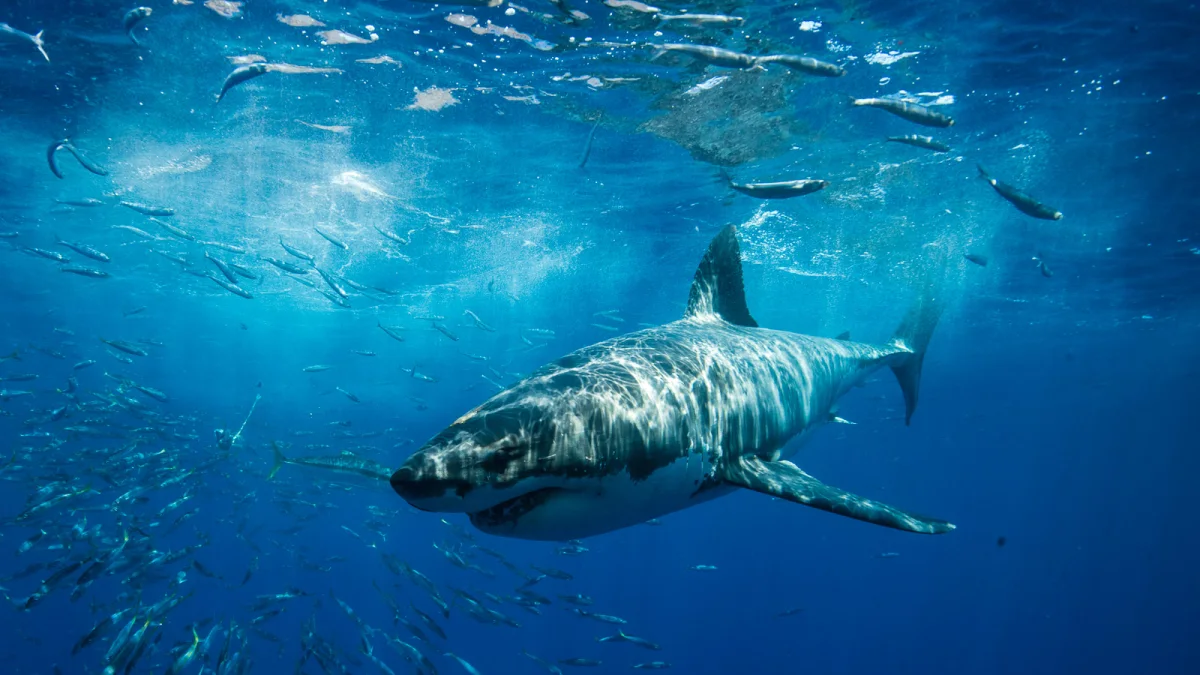
Shark diving in
Guadalupe IslandHighlights
- Close encounters with over 300 individually identified great white sharks
- Surface and submersible caged experiences, with a focus on safety
- Incredible visibility, topping out at over 40 metres
- Remote, liveaboard-only setting with just a handful of boats on the water
Update Jan 2024 - Guadalupe Island has been closed to tourism and other activities by order of the Mexican authorities. Guadalupe Island shark diving is some of the best on the planet. This volcanic island, over 200 kilometres off Mexico's Pacific coast, was once home to massive fishing, fur, and logging operations. Today, it's one of the best places in the world to observe great white sharks - with over 300 identified individuals making the annual migration to visit these remote waters. Guadalupe can only be visited by liveaboard during a short, four-month season, so you can expect an off-the-beaten-path atmosphere that caters to the adventurous.
Shark diving at Guadalupe Island
 Great white sharksNot frequently
Great white sharksNot frequently
Simply put, Guadalupe shark diving is completely different from a traditional liveaboard experience. Rather than exploring the marine park's barren and rocky dive sites, divers spend their time in cages, observing one specific species - great white sharks. Most of this diving is done in blue water, with no visible reef or topographical features.
Great white shark cage diving
If you've never been cage diving, the experience might start off as a bit of a shock. First of all, you won't be given a traditional scuba setup to dive with. This type of diving uses a surface supplied air source known as a "hookah" rather than tanks. And, because divers are not permitted to leave the cage, other equipment like fins won't be used. Two types of cages are currently being deployed at Guadalupe - surface and submerged. This allows divers to observe the sharks at multiple depths and encourages a variety of interactions.
No matter which kind of cage your operator of choice uses, you'll find vital safety equipment, including backup scuba tanks inside. You'll also be spending all of your cage time with highly-trained instructors, guides or safety divers. This is to help protect the clients, as well as the sharks. Most operators provide three to four shark experiences each day. And, some even sweeten the deal with unlimited time in surface cages - ideal for underwater photographers and dedicated shark enthusiasts.
Because Guadalupe diving is all about great white sharks, liveaboard operators use lures and bait to draw the animals in from the open ocean. During the beginning of the season, from July through August, you're most likely to spot groups of juvenile male sharks. These encounters are high-adrenaline, as the sharks are often seen striking lures on the surface and sometimes even breaching. As the season progresses, more females arrive on the scene. And, by the time October rolls around, these waters are dominated by supersized señoras - massive females that top this region's food chain. Many of these individuals are known on sight, making well-documented visits to Guadalupe year after year!
Diving Environment
Cage diving with great white sharks
Beginner to advanced and beyond
July to November
Surface to 10m
20 - 24m+
20 - 22C
Top tips
- This is not a traditional liveaboard diving experience - all dives are conducted from cages.
- Be sure to choose an environmentally conscious operator with high standards for the sharks' safety as well as the clients'.
- Keep your camera handy on deck - great whites are known to put on quite a show both above and below water.
- Combine your adventure in Guadalupe with a trip to Revillagigedo for the ultimate eastern Pacific diving adventure!
About Guadalupe Island
Were it not for the national park, Guadalupe would be reduced to a barren and uninhabited rock surrounded by Mexico's Pacific. Once a remote fishing, sealing, and then logging camp, this is now one of Mexico's most impressive examples of marine park protection on the Pacific that has found fame as one of the ultimate shark diving destinations in the world.
Guadalupe Island is the perfect habitat for great white sharks, who prefer to gather in protected bays and coves close to their favourite food sources. The sharks are also able to capitalise on the California Current, which brings cold and nutrient-rich water to the region. This, in turn, encourages phytoplankton to grow, which attracts a variety of prey species that the sharks rely on. Guadalupe's white sharks also use the island's natural features for hunting. The combination of deep water, crystal clear visibility, and an easy backdrop of grey rock to blend into gives these apex predators the upper hand while searching for their favourite meals - fur and elephant seals.
As a tourist destination, Guadalupe is still working its way into the mainstream. The island has a short diving season and can only be reached by multi-day liveaboard safaris thanks to its far-flung location off the coast of Colima state in Mexico's Pacific.
Getting there
Because there are no tourist services on Guadalupe Island, the region can only be dived via liveaboard. The island can be reached from Ensenada in Mexico or San Diego in the US, with crossings lasting up to 20-hours. Which is right for you depends on the rest of your travel plans, and no matter which port you sail from, be sure to pack a few creature comforts from home to help you pass the time at sea.
Both San Diego and Tijuana (found an hour and a half north of Ensenada) host international airports with regular flights from the United States and Canada, Western Europe, and Asia. On arrival, you'll connect to the San Diego or Ensenada marina by local bus, taxi, or private transport. Once you reach Guadalupe Island, you'll be diving straight from your liveaboard's main deck. So, there won't be any surface boat rides to worry about.
Where to stay
A wide variety of vessels are currently operating in the area, with options ranging from relaxed operations to luxurious liveaboards that feel more like floating boutique hotels than boats. No matter which type of adventure you prefer, you'll spend all of your time onboard, as snorkelling and watersports are prohibited around the island - and visitors are not allowed to go ashore.
No two operators run their trips in exactly the same way. Some vessels offer both submerged and surface cages, letting you spend far more time in the water. Others balance diving with leisure, with three to four shark experiences each day. Snorkelling and other watersports are prohibited in Guadalupe, so it's essential to consider how much time you'll be happy to spend above the water when choosing your itinerary and vessel.
Most divers opt to spend a day or two exploring San Diego or Ensenada before and after their expedition. These popular seaside resorts are both found close to the border between the United States and Mexico, a region known for outstanding cold water diving, as well as surfing and wind sports.
Guadalupe diving seasons and weather
Guadalupe Island has a short diving season, running from July through November. Outside of these months, the region's notorious sharks migrate elsewhere. And, because Guadalupe is a "blue water" diving destination with no reefs to explore, there is little else to see.
The season starts in July, with gangs of rowdy male sharks known for their quick strikes and close passes. Small females then join these sharks during August and September. October and November are dominated by supersized females, with some of the Pacific's largest known individuals making appearances.
While diving in Guadalupe Island, Mexico, you can expect water temperatures between 20-22°C every day. But, because you'll be mostly motionless inside the cage, it's easy to feel the chill. So, pack an extra layer or two of exposure protection just in case. Above the waves, you can expect hot, sunny days and cool breezy nights at sea.
Conservation
Between 1870 and 1885, Guadalupe Island and its surrounding islets were bought and sold multiple times in a series of dubious business deals. During this period, the island, which was once home to a thriving tropical cloud forest, was reduced to sheer rock thanks to logging and the introduction of invasive livestock. Once the Mexican government regained control of the island, it remained largely untouched until 1975, at which point it became a nationally declared pinniped sanctuary.
Since then, the island's marine park protection status has been constantly on the rise. And, with the introduction of cage diving in the year 2000, Guadalupe has slowly become more and more popular among divers in the know. This is one of the only places on planet earth where great white sharks can be seen in such impressive numbers. And, thanks to the island's protected biosphere status, the shark numbers here are even on the rise!
Listed as a vulnerable species by IUCN, great white sharks are one of the many species threatened by human intervention. These large apex predators are not only at risk of being caught accidentally by commercial fishermen, but are even targeted for their fins, as well. Thankfully, today, Guadalupe's great white sharks are worth more alive than they are dead - one of the only proven protection strategies currently working the world over. But is great white shark cage diving at Guadalupe Island ethical? The easy answer is that it depends on who you dive with! Some operators are using increasingly unsustainable tactics to bring the sharks in closer to dive groups - which can have dire results. Before booking your trip, be sure to consider your company of choice's practices when it comes to baiting and chumming. And, check out ZuBlu's article on safe and responsible shark interactions for more helpful information!




























